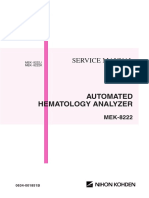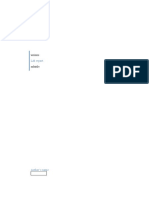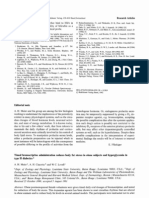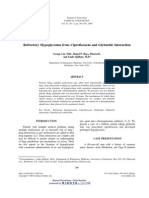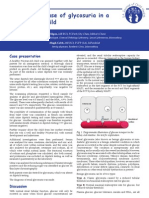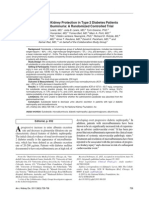Role of Sugars in Human Neutrophilic Phagocytosis
Role of Sugars in Human Neutrophilic Phagocytosis
Uploaded by
dumitrudragosCopyright:
Available Formats
Role of Sugars in Human Neutrophilic Phagocytosis
Role of Sugars in Human Neutrophilic Phagocytosis
Uploaded by
dumitrudragosCopyright
Available Formats
Share this document
Did you find this document useful?
Is this content inappropriate?
Copyright:
Available Formats
Role of Sugars in Human Neutrophilic Phagocytosis
Role of Sugars in Human Neutrophilic Phagocytosis
Uploaded by
dumitrudragosCopyright:
Available Formats
Role of sugars in human neutrophilic phagocytosis
Albert Sanchez, P. J. McMillan,
J. L. Reeser, H. S. Lau, P. Y. Yahiku, R. E. Willard, S. Y. Cho, A. R. Magie and U. D. Register
ABSTRACT decreased this from incubated number of to slides fructose, effect, the the and arm with of bacteria prepared sucrose, This phagocytic c) the study effect was capacity of designed fasting fast of within Wrights or orange by index fasting each stain. juice the slide on and to test a) whether carbohydrates human 3, or 5 hr The by of the subjects, Venous postprandial phagocytic microscopic capacity did but not the other b) the blood than was and index from have values this were glucose of drawn this was (mean glucose, effect.
of neutrophils at 0.5,
in normal 1, 2, was lOOi
duration
neutrophihic
phagocytosis.
after
a
an
viewed with
overnight
suspension
Staphylococcus neutrophil) Oral
epidermidis.
determined portions Starch hr decreased
examination of neutrophils carbohydrates. still
carbohydrate
honey, phagocytic
all significantly technique.
The
The
engulf bacteria decrease in
greatest
below index the the
as measured
occurred
the
ingestion
was rapid following
1 and
values 2 5 hr control after
the ingestion
postprandial, feeding
of simple
Downloaded from www.ajcn.org by on January 9, 2010
effects
between
significantly phagocytic suggest that
(P < 0.00 1). The
neutrophils. by ingestion
decreased
These data of sugars.
was not significantly function and not the
associated with the number of phagocytes
number of was altered
This
shows increased
implicates
that
glucose
effects last the
and
for
other
at least
simple
5 hr. index.
carbohydrates
On the other
in the
hand,
control
26:
of phagocytosis
hr significantly 1973. 1180-1184,
and
a fast
of 36 or 60
(P < 0.001)
phagocytic
Am.
J. Clin. Nutr.
A mals
major is
defense neutrophilic
mechanism phagocytosis
of
higher (1,
ani2).
Phagocytosis is an energy requiring mechanism that is inhibited by an inadequate supply glucose (3). On the other hand, there
evidence to suggest that an excess of glucose
of is
The purpose of these studies was to a) test whether ingestion of carbohydrates other than glucose decreases neutrophilic phagocytosis, b) determine how long neutrophilic phagocytosis remains lowered after oral administration of carbohydrate, and c) test whether fasting (the
absence neutrophilic of oral glucose phagocytosis. sources) affects
may also decrease phagocytic activity. Patients with diabetes mellitus are characterized by elevated blood glucose levels and lowered resistance to infection. Diabetics have also been found to have impaired neutrophilic phagocytosis as compared with normal subjects (4-7). Kijak et al. (8) found that the greater the blood glucose level the lower the phagocytic capacity in diabetic patients. Moreover, oral administration of increasing amounts of glucose progressively lowered the phagocytic capacity of neutrophils in normal subjects (8) or patients (9) when measured at 45 mm postprandial. Thus, both the ingestion of glucose and the level of glucose in the blood seem to be implicated in the control of neutrophilic phagocytosis. There seems to be no further information relating carbohydrates with neutrophilic phagocytosis or with the duration of decreased phagocytosis following glucose ingestion.
1180
Methods
Ten subjects for the study. subjects were addition, eight (6 females and 4 males) volunteered Except for one teenage boy, the between the ages of 20 and 34. In patients with abnormal blood glucose
levels
following
glucose
loading
were
also
studied.
After an overnight fast of approximately 12 hr, each subject was given 100 g carbohydrate. This included glucose, starch, fructose, and sucrose, and the carbohydrate in honey and orange juice. The carbohydrate in honey is comprised of: glucose, 44%; fructose, 52%; sucrose, 2%; and dextrin, 2%; and that of orange juice
From the Departments of Nutrition, Biostatistics, Environmental Health in the School of Health, and the Department of Microbiology, Pathology, and Anatomy in the School of Medicine, Loma Linda and
University,
2Presented
Loma
at
Linda,
the
California
IX International
92354.
Congress of
Nutrition, 26: NOVEMBER
Mexico 1973,
City,
pp.
September
1180-1184.
3 to 9, 1972.
Printed in U.S.A.
The American
Journal
of Clinical
Nutrition
CARBOHYDRATES is glucose, Each day 25%; of the fructose, study, 25%; and sucrose, 48% various carbohydrates (10). were
AND
PHAGOCYTOSIS
1181
the
administered, with each subject receiving a different carbohydrate until he had completed the series of six carbohydrate sources. Blood was drawn at 0 (12-hr overnight fast), 0.5, 1, 2, 3, and 5 hr postprandial. The 0.5-hour time period blood was not drawn for all the subjects on all of the carbohydrates. For the 1-, 2-, and 3-hr periods, more than the 10 original subjects participated with fructose, sucrose, honey, and starch. As values for the phagocytic index were similar to those of the 10 subjects, these were also included in
the saline suspension to 18% transmittance at a wave length of 420 nm. Each subject served as his own control and the 12-hr fasting value was the control for each subject. The general linear hypothesis model (11) and linear regression (12) were used for statistical analysis.
Results
and discussion
the analyses.
Seven subjects ranging from 23 to 51 years old volunteered in the study to test the effect of fasting on phagocytosis. After the 12-hr fast (as above), the subjects drank approximately 8 oz cold water and thereafter they were allowed only water ad hibitum for an additional 48 hr, or a total of 60 hr. At the end of 12 hr, instead of receiving 100 g carbohydrate these subjects drank 8 oz cold water; blood samples were collected at the times coinciding with the 0-, 2-, and 5-hr sampling periods of the carbohydrate-fed subjects. Blood was drawn from the arm between 7 and 8 AM with a heparimzed tube for the phagocytic determinations and with an oxalated tube for determinations of plasma glucose (alkaline ferricyanide reducing sugar method), total white cell count, neutrophil count, total red blood cell count, hemoglobin, and hematocrit. A sample of 0.9 ml freshly drawn blood was mixed
in siliconized tubes and suspension of Staphylococcus
rotated mechanically end
stoppers
with
0.1
ml saline
was min.
epidermidis. This to end at 37 C for 30
The phagocytic index, the first 50 neutrophils in slides stained with
the mean
viewed
number
under the
of bacteria
microscope
in on
Wrights
of bacteria
stain,
available
is dependent
for ingestion
the
relative
number
by the adjusted
15 on
leukocytes. The bacteria concentration was to give a phagocytic index of approximately
the control fasting blood samples by diluting
Table 1 shows the total white cell count, neutrophil count, total red blood cell count, hemoglobin, and hematocrit. These values were within the laboratory normal range for both males and females during each of the time periods in which blood was drawn. There were no apparent trends in these parameters following the ingestion of carbohydrates. Table 2 shows the phagocytic index and plasma glucose of normal human subjects fed different carbohydrates after an overnight fast. The highest phagocytic index was found before ingestion of each carbohydrate. The lowest phagocytic index occurred between 1 and 2 hr postprandial with all the sugars. This drop of approximately 50% in phagocytic activity was significant (P < 0.001) as compared with fasting values. In contrast, starch ingestion did not lower the phagocytic activity of leukocytes as did the other carbohydrates and the difference between starch and sugars during the S-hr postprandial period was highly significant (P < 0.001). The results with starch contrasted with the mean averages SE of the other carbohydrates are shown in Fig. 1. Our findings with glucose as shown graphically in Fig. 2 support
Downloaded from www.ajcn.org by on January 9, 2010
TABLE
Mean red neutrophils
1
blood cell count (RBC), at each time interval white blood for men and cell count women on (WBC), hemoglobin, the various carbohydrate hematocrit, groups and number of
Parameter measured Females (6) RBC(X 10)/ml
Normal range
Fasting
30
mm
1 hr
2 hr
3 hr
5 hr
4.2-53
12-15 37-47 4.5-10 40-60
HGB,g/100
ml
HCT, % WBC (X 103)/mh Neutrophils, % WBC Males (4)a RBC (X 106)/ml HGB,g/lOOml HCT, % WBC (X 103)/ml
Neutrophils, % WBC
4.10.1 12.1 0.2 36.5 05 5.3 0.2 43 6
4.10.1 12.1 36.8 5.5 35
0.2
0.5 0.3
6
4.10.1 12.2 0.2 37.0 0.6 5.7 0.2 52 6
4.10.1 12.1 0.1 36.5 0.6 5.5 0.2 50 7
4.00.1 11.9 0.2 35.8 0.6 5.4 0.2
44
4.00.1 12.0 0.2 36.6 0.6 6.4 0.3
55
4.5-6
5.2
0.0
0.1 0.3 0.2
5
5.2
14-16.5 45-5 2 43-10
15.1 44.6 4.7
14.8 44.3 4.4
45
0.0 0.1 0.3
0.2 7
5.1 15.9 44.0
4.5 49
0.1 0.1 0.3
0.2
5.2 15.0 44.5
4.7
0.1 0.2 0.5
0.2 5
5.2 14.7 44.1
4.9
0.1 0.2 0.5 0.2
40-60
indicated
59
50
46
5.1 14.8 43.8 5.4 53
0.1 0.2 0.5 0.3 6
Number
of subjects
in parentheses.
1182
SANCHEZ
ET
AL.
TABLE 2 Neutrophilic
after
an overnight
phagocytosis fast
and
plasma
glucose
of human
subjects
fed
different
carbohydrates
Time Treatment parametermeasured and Fasting
(1013)b
af ter
100-g 1 hr (10-13)
carb ohydrate 2 hr (9-11)
oral
dose 3 hr (9-lI)
30 mm (5-10)
5 hr
(6-10)
Glucose
Phagocytic indexC Plasma glucose, mg/dl 16.2 86 153 89 15.2 90 15.9
09d,e
13.8 117
13.3 965 12.1
1.3
9
2.0
11.7 97 8.5 96
0.8
9.6
0.6
12.9
0.6
13.5
7
0.9 2 0.9 5 0.9
88
9.7 89 9.3
7
1.2 3 0.7
67
11.0 87 12.5
4
0.9 2
77
12.8 81 15.0 80 12.7 87 11.7
0.7 2
1.1 3 1.3 3 1.0 2 0.8
Fructose
Phagocytic index Plasma glucose, mg/dl Sucrose Phagocytic index Plasma glucose, mg/dl Honey Phagocytic index 1.0 3 1.0
1.7
2
0.9
110
15.9
7
1.7
8.6 88
9.7
82
9.7
2
0.9
79
12.4 81 13.2
1.1 3 1.1 4 1.4
Plasmaglucose,mg/dl
Orange juice Phagocytic index
89
16.6
1
1.2
115
12.6
15
1.0
895
10.1
75
1.3
3
0.8
Downloaded from www.ajcn.org by on January 9, 2010
9.6
86
14.1
Plasma
Starch
glucose, index
glucose,
mg/dl
89 15.7
2 0.8 2
114 17.1 98
9
1.3 7
b
93
14.4 96 Numbers
4
0.9
4 1.1
3 indicate
86
14.6 83
2
1.3 3
81
13.6 85 per
2
0.7
Phagocytic
Plasma
mg/dh
88
83
in parentheses
2
for
overnight fast of approximately time intervals and different epidermidis) viewed within each neutrophil. text. The significant reduction in phagocytic each of the various simple carbohydrates (P< 0.001) than with starch. the
After an various
12 hr. carbohydrates.
subjects
group
number of bacteria ( Mean standard error. e Statistical analyses index (P < 0.00 1) was statistically indistinguishable
C
Mean
(Staphylococcus are given in the after feeding
significantly less
and
the
phagocytic
index
with
the
sugars
was
findings that glucose ingestion lowered the phagocytic index (8). By the use of a general linear hypothesis model that included patient and diet effects, it was found that the phagocytic activity was still significantly lower (P < 0.001) at S hr postprandial than before feeding and that the return to the control fasting values was similar for each of the sugars. Statistical analyses also provided no evidence that the number of neutrophils are related to the phagocytic index. earlier
This would lead to the conclusion that a decreased phagocytic index is associated with impaired function rather than the number of leukocytes. Data from Bybee and Rogers (7) support this conclusion by showing that leukocytes with normal activity phagocytized normally when placed in serum from ketoacidotic diabetic patients, but leukocytes from ketoacidotic patients had impaired phagocytosis even when placed in serum from non-ketoacidotic chemotaxis patients. of Evidently, leukocytes there of is a decreased patients diabetic
that is reversed by insulin (9), but the mechanism of action is not known. Table 2 also shows the plasma reducing sugar concentrations. Comparable but lower values were obtained by use of the glucose oxidase method. The fasting (zero) values were essentially the same for all groups. This might be expected because 10 values in each group were from the same 10 subjects, taken on different days. The plasma glucose concentration was elevated within 0.5 hr postprandial. The rate of return to fasting levels, including overshoot, appears to vary according to the type of carbohydrate ingested. This may be related to varying rates of absorption of carbohydrates from the gastrointestinal tract and/or varying rates of conversion of ingested carbohydrates to glucose. The degree of overshoot of the blood glucose control mechanisms may also play a role according to the specific carbohydrate ingested. No significant relationship was found between plasma glucose levels and phagocytic
CARBOHYDRATES
AND
PHAGOCYTOSIS
1183
C C U
I
2 3 4
Hours FIG. 1. Comparison starch on the phagocytic
postprondial of the index effects of sugars after an overnight and fast (solid
in
normal
The
human
values
subjects
for starch
ingesting
100
g carboerror
hydrate.
standard
line) and for the sugars standard (broken line) are derived from
include juice. glucose, fructose, sucrose,
error of their means
Table
honey,
2. The
and
sugars
orange
1$ 115 1$
Phagocytic index
105
0
0)
carbohydrate were employed and these amounts may be above the threshold response levels for glucose and phagocytic index in normal subjects. Table 3 shows the phagocytic index and plasma glucose of eight patients having a glucose tolerance curve of the diabetic type. The lowest phagocytic index values of the entire study were obtained with this group for the fasting through the 3-hr postprandial period. The highest blood glucose levels were also obtained with this group. Therefore, decreased phagocytosis may be the result of elevated blood glucose levels. Our results are in agreement with Kijak et al. (8) relating the decreased phagocytic activity to the increased glucose concentration in diabetic patients. These observations are consistent with those of others (4-7) who found lower phagocytic activity in neutrophils of diabetic patients as compared with normal subjects. In the fasting study the mean red blood cell count, hemoglobin, hematocrit, white blood cell count, and number of neutrophils at each fasting time interval for men and women were variable but mostly within laboratory normal limits. There were no obvious trends with fasting in any of these parameters. Figure 3 graphically shows the mean phagocytic index and blood glucose levels for the seven subjects at the various time intervals during fasting. During the S-hr period in the morning of the 1st day of fast, there was no significant change in either the phagocytic index or the blood concentration. This time period corresponds to the same S-hr period after ingestion of carbohydrates as shown in the experiments above. This shows that the drop in phagocytic activity after carbohydrate administration was due to dietary effects and not to a
Downloaded from www.ajcn.org by on January 9, 2010
14
$5
0
#{149}
12
1
0
]
i::
g, 0
L:$
a.
I I
.2
a.
65 .5 1 2 3 4
Hours
postprandial
FIG.
2. The
phagocytic
index
of neutrophils
(solid
line) and blood blood of normal glucose after
glucose concentration (broken line) in human subjects after ingesting 100 g an overnight fast. The vertical lines
TABLE
Plasma
3
glucose patients Time level and neutrophiic given an oral 1 O0-g Plasma dose phagocytosis of glucose Phagocytic in
represent
the standard
deviations.
eight
index linear glucose changes and 2 al. (8) plasma diabetic
in the normal subjects by use of a general hypothesis that tested the 30-ruin to 1-hr level changes (highest values) with in phagocytic index between fasting hr (lowest values) after feeding. Kijack et reported an inverse relationship between glucose and phagocytic activity in patients. In our studies, l00-g doses of
interval
Fasting
glucose
102
index 5 17
12.4 0.7 0.9 7.20.8 5.30.7 9.7 1.1
30mm
lhr 2hr 3hr Mean
187
9.1
23126 18530 126 23
standard
error
of the
mean.
1184
SANCHEZ
ET
AL.
is
Phogocytic nd.,
1S
14
12
0 0i 0 -C
Plasma
a.
5.
cytosis is the rate limiting step in the reduction of viable organisms (3). Thus, diet may play a key role in the control of resistance to infection. We are presently studying the effects of various levels of carbohydrates as well as the possible role of protein, fat, and ordinary meals on neutrophilic phagocytosis. Another unanswered question is whether the effects on phagocytosis are due to the specific carboss hydrate directly or to generalized mechanisms
1214
17
is
Hours Fasting
51
index of neutrophils (solid
that
control
glucose
levels.
FIG.
3. The
phagocytic
References 1. METCHNIKOFF, E. Lectures on the Comparative Pathology of Inflammation. London: Kegan, Paul,
2. 3. Trench, Trubner MENKIN, V. York: Macmillan, COHN, Z. A., & Co., 1893. Dynamics of inflammation. 1940. AND S. I. MORSE. Functional
line) and glucose concentration of human subjects during fasting period corresponds hours) in Figs. 1 and 2.
(broken line) in blood a 60-hr fast. The 12-hr to the overnight fast (or 0
Downloaded from www.ajcn.org by on January 9, 2010
New and
phenomenon normally occurring during this time of the day. Statistical analysis of the entire fasting period shows that the within groups regression coefficient was significantly greater than zero (P < 0.00 1), which indicated a significant increase in phagocytic index due to the 36- and 60-hr fast. The glucose concentration during this time obviously did not drop to such a low level as to inhibit phagocytosis by depleting the leukocytes of their energy source. The maintenance of lowered blood glucose levels in the lower portion of the normal fasting range by limited fasting may provide a clinical method of enhancing the bodys defenses against infection by increased phagocytosis. Our studies were intended to determine the effects of carbohydrates on neutrophiic phagocytosis and the duration of these effects. We found that sugars impaired the neutrophils to engulf bacteria. The greatest reduction in phagocytosis occurred at approximately 2 hr postprandial but the effects were still evident 5 hr after ingestion. In contrast, a fast of 36 to 60 hr enhanced the phagocytic capacity of neutrophils. This implicates carbohydrates in the enhancement and inhibition of neutrophilic phagocytosis. These observations become meaningful when it is recognized that phago-
metabolic
properties
of polymorphonuclear
on the requirements ingestion. J. Exptl.
leucoand Med.
cytes. I. Observations consequences of particle 111:667,1960.
4.
DaCOSTA,
3. C.,
AND
E.
BEARDSLEY.
The
5.
resistance of diabetes to bacterial infection. Am. 3. Med. Sci. 136: 361, 1908. RICHARDSON, R. Measurements of phagocytic activity in diabetes mellitus. Am. 3. Med. Sci. 204: 29, 1942.
6.
SCHAUBLE, M. K., AND R. D. BAKER. The inflammatory response in acute alloxan diabetes. AMA Arch. Pathol. 64: 563, 1957. 7. BYBEE, 3. D., AND D. E. ROGERS. The
phagocytic activity of polymorphonuclear leukocytes obtained from patients with diabetes mellitus. 3. Lab. Chin. Med. 64: 1, 1964. KIJAK, E., G. FOUST AND R. R. STEINMAN. Relationship of blood sugar level and leukocytic
8.
phagocytosis. 3. So. Calif. Dental 1964. 9. MOWAT, A. G., AND J. BAUM.
polymorphonuclear leukocytes
Assoc.
32: 349,
of with 621,
Chemotaxis
diabetes
1971. 10.
mellitus.
New
Engl.
from patients J. Med. 284:
HARDINGE, M. G., CROOKS. Carbohydrates Assoc. 46: 197, 1965.
J. B. SWARNER AND H. in foods. J. Am. Dietet.
11.
12.
GRAYBILL, F. A. An Introduction to Linear Statistical Models. New York: McGraw-Hill, 1961, vol. 1. DIXON, W. J., AND F. J. MASSEY. Introduction to Statistical Analysis. New York: McGraw-Hill, 1969.
You might also like
- Lal Path ReportDocument7 pagesLal Path Reportrahulyadavsai123100% (3)
- 31xslpwwecklimaorajhkquuDocument7 pages31xslpwwecklimaorajhkquukutush2007No ratings yet
- Sample Case ProtocolDocument6 pagesSample Case ProtocoljheyfteeNo ratings yet
- Tertiary LabDocument7 pagesTertiary LabJaycarlo SaltivanNo ratings yet
- Nihon KohdemDocument246 pagesNihon KohdemЛенаNo ratings yet
- Amj-Hiponatremia Corregida Por Hiperglicemia-1999Document5 pagesAmj-Hiponatremia Corregida Por Hiperglicemia-1999Mayra Alejandra Prada SerranoNo ratings yet
- The Impact of Delayed Analysis On Glucose Levels of Blood SamplesDocument4 pagesThe Impact of Delayed Analysis On Glucose Levels of Blood SamplesInternational Journal of Innovative Science and Research TechnologyNo ratings yet
- Disturbance of Serum Viscosity in Diabetes Mellitus: Donald E. McmillanDocument9 pagesDisturbance of Serum Viscosity in Diabetes Mellitus: Donald E. McmillanEky SeptianNo ratings yet
- Efecto de CetonaDocument9 pagesEfecto de CetonaGiusi CaforioNo ratings yet
- Basal Glucosuria CatDocument7 pagesBasal Glucosuria CatIoana SanduNo ratings yet
- Factors Affecting Gluconeogenesis in The Neonatal Subhuman Primate (Macaca Mulatta)Document8 pagesFactors Affecting Gluconeogenesis in The Neonatal Subhuman Primate (Macaca Mulatta)Saleth CortezNo ratings yet
- ImplantDocument8 pagesImplantTabishur RahmanNo ratings yet
- Comparative Study of The Concentration of Salivary and Blood Glucose in Type 2 Diabetic PatientsDocument6 pagesComparative Study of The Concentration of Salivary and Blood Glucose in Type 2 Diabetic PatientsdhiananatashaNo ratings yet
- Diabetes-2000-Cersosimo-1186-93 Renal Substrate Metabolism and GluconeogenesisDocument8 pagesDiabetes-2000-Cersosimo-1186-93 Renal Substrate Metabolism and GluconeogenesisSarah KKCNo ratings yet
- Continuous Glucose Profiles in Healthy Subjects Under Everyday Life Conditions and After Different MealsDocument9 pagesContinuous Glucose Profiles in Healthy Subjects Under Everyday Life Conditions and After Different MealsAsose TuNo ratings yet
- Ginger PublishedDocument8 pagesGinger PublishedFatimoh AbdulsalamNo ratings yet
- Induction of Diabetes by Streptozotocin in RatsDocument5 pagesInduction of Diabetes by Streptozotocin in RatsJusty GuavaNo ratings yet
- #4 (Sofà A)Document6 pages#4 (Sofà A)Sofia OrduñoNo ratings yet
- Humans With Type 2 Diabetes: - Cell Deficit and Increased - Cell Apoptosis inDocument9 pagesHumans With Type 2 Diabetes: - Cell Deficit and Increased - Cell Apoptosis ingrilo604No ratings yet
- Jurnal LisinoprilDocument7 pagesJurnal LisinoprildidiisafitriNo ratings yet
- ACBR - Manuscript - 008 CorrectedDocument10 pagesACBR - Manuscript - 008 CorrectedFabian PitkinNo ratings yet
- Writors: Lab ReportDocument12 pagesWritors: Lab ReportTalha NaseemNo ratings yet
- Jcinvest00248 0177 PDFDocument11 pagesJcinvest00248 0177 PDFluis morales garzaNo ratings yet
- tmpD4AC TMPDocument14 pagestmpD4AC TMPFrontiersNo ratings yet
- High Dose Vs Low DoseDocument6 pagesHigh Dose Vs Low DosenivethitaNo ratings yet
- PHD Thesis: University of Medicine and Pharmacy CraiovaDocument10 pagesPHD Thesis: University of Medicine and Pharmacy CraiovapaulNo ratings yet
- Measurement of Glucose Homeostasis in VivoDocument10 pagesMeasurement of Glucose Homeostasis in Vivo19400668No ratings yet
- The Effect of Aloin in Blood Glucose and Antioxidants in Male Albino Rats With Streptozotocin-Induced DiabeticDocument18 pagesThe Effect of Aloin in Blood Glucose and Antioxidants in Male Albino Rats With Streptozotocin-Induced DiabeticJunaid MinhasNo ratings yet
- Phagocytic Activity Is Impaired in Type 2 Diabetes Mellitus and Increases After Metabolic ImprovementDocument6 pagesPhagocytic Activity Is Impaired in Type 2 Diabetes Mellitus and Increases After Metabolic ImprovementJenny JennyssimaNo ratings yet
- 7decaf9c Cb18 4623 Bced Ecef2197e451Document25 pages7decaf9c Cb18 4623 Bced Ecef2197e451PrabhuNo ratings yet
- Akbarzadeh 2007 Induksi STZ Diabetic PDFDocument5 pagesAkbarzadeh 2007 Induksi STZ Diabetic PDFPutri MauraNo ratings yet
- Lipid Profile in CKDDocument4 pagesLipid Profile in CKDAmiyanshu BeheraNo ratings yet
- Many Randomnized Clinical TrialDocument1 pageMany Randomnized Clinical Trialexcemyclinicals.officialNo ratings yet
- Phys ResDocument18 pagesPhys ResFitri Nur DiniNo ratings yet
- Jci37385 PDFDocument13 pagesJci37385 PDFNur Ahmad HabibiNo ratings yet
- Anemia in Canine Chronic Kidney Disease Is Multifactorial2Document6 pagesAnemia in Canine Chronic Kidney Disease Is Multifactorial2vanessadllpNo ratings yet
- Plasma and Salivary Glucose in Diabetics Attending Tertiary Hospital in Maiduguri, Northeastern NigeriaDocument3 pagesPlasma and Salivary Glucose in Diabetics Attending Tertiary Hospital in Maiduguri, Northeastern NigeriaChiranjeevi Kumar EndukuruNo ratings yet
- Complementary and Alternative Medical Lab Testing Part 6: Liver and GallbladderFrom EverandComplementary and Alternative Medical Lab Testing Part 6: Liver and GallbladderNo ratings yet
- Hipertensión IntraabdominalDocument24 pagesHipertensión IntraabdominalAnonymous QNRRaQUNo ratings yet
- Diabetic Ketoacidosis in A Hospital Based Population in PakistanDocument6 pagesDiabetic Ketoacidosis in A Hospital Based Population in Pakistanhasnainhamid668No ratings yet
- 1472 6882 2 1 PDFDocument7 pages1472 6882 2 1 PDFThiago NunesNo ratings yet
- GunebakanetalDocument13 pagesGunebakanetalatesnilayNo ratings yet
- Full TextDocument6 pagesFull Textdrsandeepjagdale1No ratings yet
- Barnett 1988Document6 pagesBarnett 1988afifahridhahumairahhNo ratings yet
- Pathophysiology of Hypertrophic PyloricDocument9 pagesPathophysiology of Hypertrophic PyloricVașadi Razvan CristianNo ratings yet
- jpc120014 63 70Document8 pagesjpc120014 63 70tehbizzNo ratings yet
- Serum Uric AcidDocument7 pagesSerum Uric AcidAnonymous ceYk4p4No ratings yet
- Javma 237 3 299Document5 pagesJavma 237 3 299tcvhNo ratings yet
- Focal Single Intravenous Aminonucleoside: Following Dose PuromycinDocument7 pagesFocal Single Intravenous Aminonucleoside: Following Dose PuromycinFauziana NurhanisahNo ratings yet
- A Case Study On Ascites of Hepatic OriginDocument4 pagesA Case Study On Ascites of Hepatic OriginFaisal MohommadNo ratings yet
- Refractory Hypoglycemia From Ciprofloxacin and Glyburide InteractionDocument4 pagesRefractory Hypoglycemia From Ciprofloxacin and Glyburide InteractionAditha PeWeNo ratings yet
- Toxicological Effects of ChloriteDocument7 pagesToxicological Effects of ChloriteAdolfo Chávez100% (1)
- Nutrition: Basic Nutritional InvestigationDocument8 pagesNutrition: Basic Nutritional InvestigationkasabeNo ratings yet
- Interdependency of Selected Metabolic Variables in An Animal Model of Metabolic SyndromeDocument4 pagesInterdependency of Selected Metabolic Variables in An Animal Model of Metabolic SyndromescribdenesimoNo ratings yet
- Obesity and Type 2 Diabetes Impair Insulin-Induced Suppression of Glycogenolysis As Well As GluconeogenesisDocument11 pagesObesity and Type 2 Diabetes Impair Insulin-Induced Suppression of Glycogenolysis As Well As GluconeogenesisFauzi RahmanNo ratings yet
- Coma, Hyperthermia and Bleeding Associated With Massive LSD OverdoseDocument6 pagesComa, Hyperthermia and Bleeding Associated With Massive LSD Overdose0j1u9nmkv534vw9vNo ratings yet
- Urologi Jurnal InternasionalDocument9 pagesUrologi Jurnal InternasionalMyisha UfairaNo ratings yet
- Renal Glycosuria Case StudyDocument2 pagesRenal Glycosuria Case StudyRodeoKenan100% (1)
- Intraplatelet Serotonin in Patients With Diabetes Mellitus and Peripheral Vascular DiseaseDocument6 pagesIntraplatelet Serotonin in Patients With Diabetes Mellitus and Peripheral Vascular DiseaseHyeon DaNo ratings yet
- Quandt 2018Document9 pagesQuandt 2018Andres Vásquez ChNo ratings yet
- Clinical Chemistry Case StudiesDocument33 pagesClinical Chemistry Case StudiesDiana Kate GalleroNo ratings yet
- 5 Revathi EtalDocument5 pages5 Revathi EtaleditorijmrhsNo ratings yet
- Sulodexide For Kidney Protection in Type 2 Diabetes PatientsDocument8 pagesSulodexide For Kidney Protection in Type 2 Diabetes PatientsFerdinand YuzonNo ratings yet
- Journal of Nutrition College, Volume 3, Nomor 4, Tahun 2014, Halaman 506-516Document8 pagesJournal of Nutrition College, Volume 3, Nomor 4, Tahun 2014, Halaman 506-516selvi aklailia rosaNo ratings yet
- Complementary and Alternative Medical Lab Testing Part 8: UrologyFrom EverandComplementary and Alternative Medical Lab Testing Part 8: UrologyRating: 3 out of 5 stars3/5 (1)
- g6pd Group 5 A2Document39 pagesg6pd Group 5 A2Kristian CadaNo ratings yet
- Pentra 60Document308 pagesPentra 60Leonardo M. MonteiroNo ratings yet
- MEK 1301 1302 - enDocument4 pagesMEK 1301 1302 - enBio AllianceNo ratings yet
- Dacie and Lewis Practical Haematology: Expert Consult: Online and Print. 12th Edition. ISBN 0702066966, 978-0702066962Document23 pagesDacie and Lewis Practical Haematology: Expert Consult: Online and Print. 12th Edition. ISBN 0702066966, 978-0702066962nollieasquithu100% (13)
- Hazarilal917 916 915 914 913 912 0Document5 pagesHazarilal917 916 915 914 913 912 0SHAKYA KuldeepNo ratings yet
- Hema 1st ShiftingDocument9 pagesHema 1st ShiftingDanielleNo ratings yet
- Abbott Alinity H Series HQ Hs HQ Spec SheetDocument2 pagesAbbott Alinity H Series HQ Hs HQ Spec Sheet郑伟健No ratings yet
- Arif Ali ReportDocument1 pageArif Ali ReportSachal LaboratoryNo ratings yet
- Serv HC 5 DDocument148 pagesServ HC 5 DNandia SassNo ratings yet
- Administrative Order No. 59 S. 2001Document16 pagesAdministrative Order No. 59 S. 2001sfefsadNo ratings yet
- Pancytopenia: Clinical Approach: Ajai Kumar Garg, AK Agarwal, GD SharmaDocument5 pagesPancytopenia: Clinical Approach: Ajai Kumar Garg, AK Agarwal, GD SharmaYudhistiraNo ratings yet
- EN-UN73 Vet (1.0)Document2 pagesEN-UN73 Vet (1.0)郑伟健No ratings yet
- Aplastic AnemiaDocument6 pagesAplastic AnemiaJoezer Gumangan VeranoNo ratings yet
- 2019 Idexx Us DosDocument148 pages2019 Idexx Us DosKevin TranNo ratings yet
- Cell DyneDocument12 pagesCell DyneLia WieNo ratings yet
- Major Case 3Document3 pagesMajor Case 3Christine Evan HoNo ratings yet
- NS 1 Quiz 7 Sas 19 23Document15 pagesNS 1 Quiz 7 Sas 19 23it's me ANGELANo ratings yet
- Toxicon: Case ReportDocument6 pagesToxicon: Case ReportBrando SaenzNo ratings yet
- TOP 1000 CPT® CODES For PEDIATRIC NURSE PRACTITIONERSDocument4 pagesTOP 1000 CPT® CODES For PEDIATRIC NURSE PRACTITIONERSbritofernandezaNo ratings yet
- Wa0110Document3 pagesWa0110venkat yeluriNo ratings yet
- Red CellDocument4 pagesRed CellUmer naeemNo ratings yet
- SmearDocument38 pagesSmeartenawNo ratings yet
- BC 700 BC 720 BrochureDocument2 pagesBC 700 BC 720 Brochure郑伟健No ratings yet
- Megaloblastic Anemia: A Case StudyDocument30 pagesMegaloblastic Anemia: A Case Studyromeo rivera100% (3)
- Medonic M Series Brichure PDFDocument6 pagesMedonic M Series Brichure PDFXUNo ratings yet




